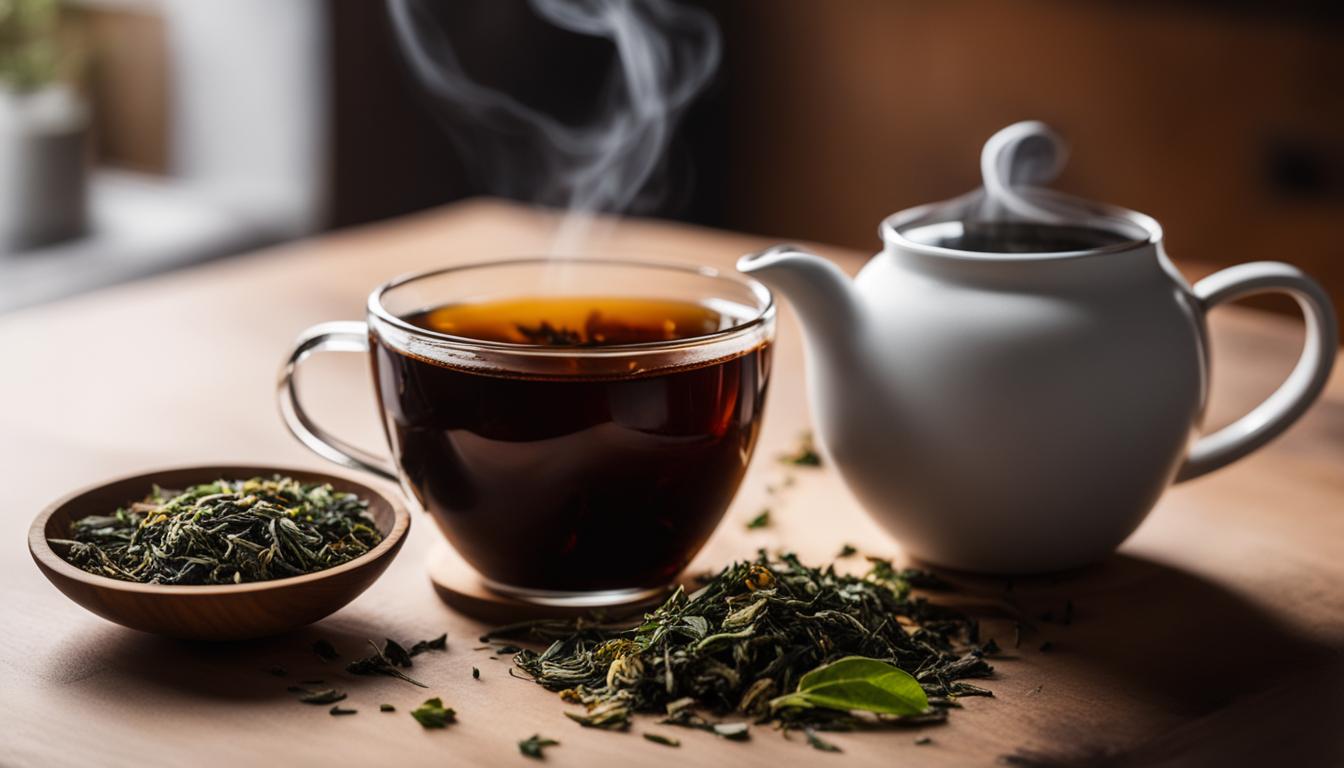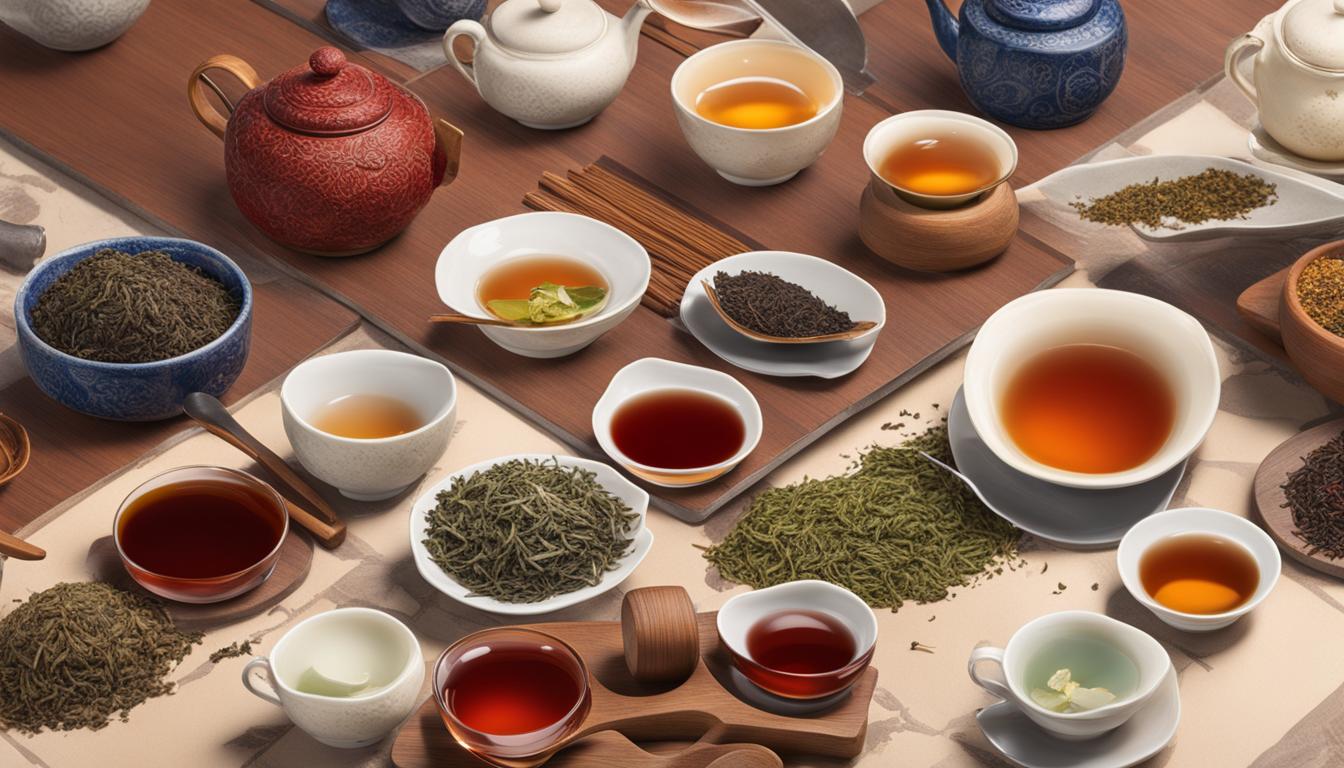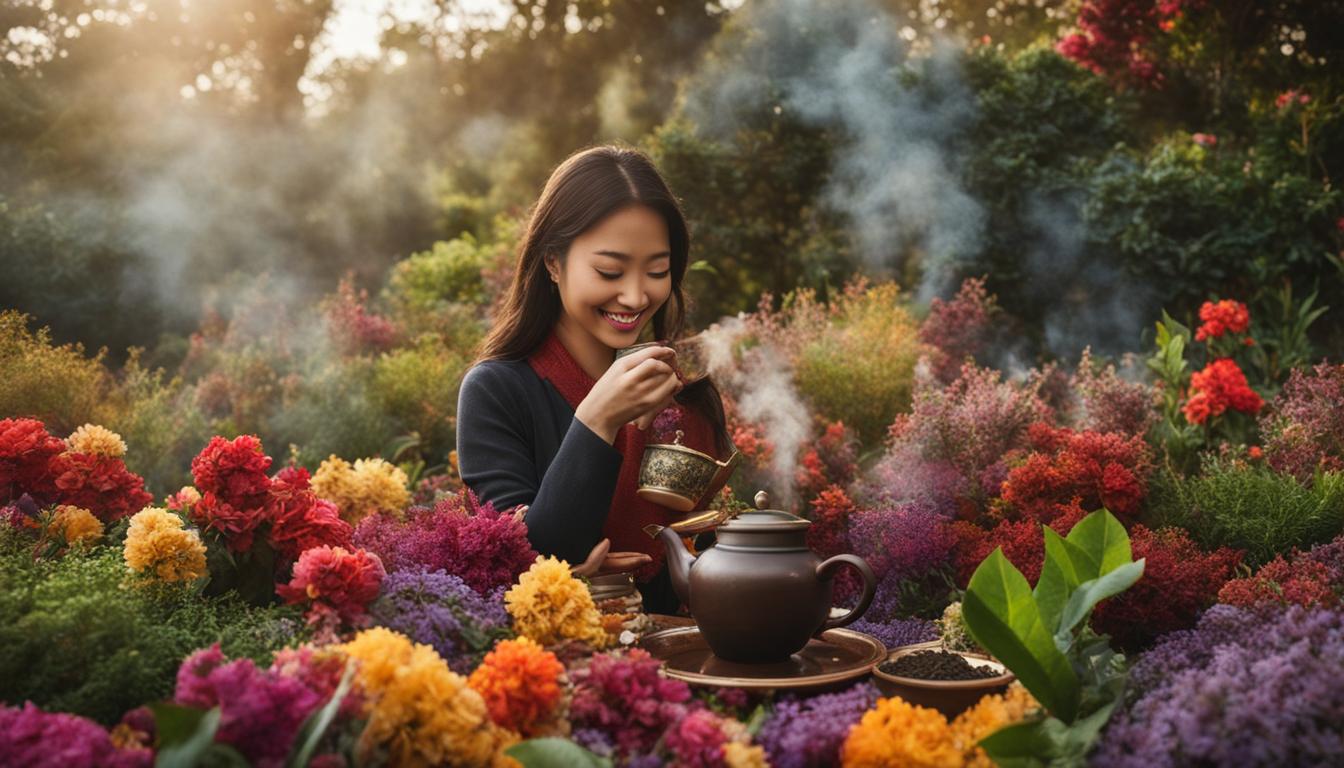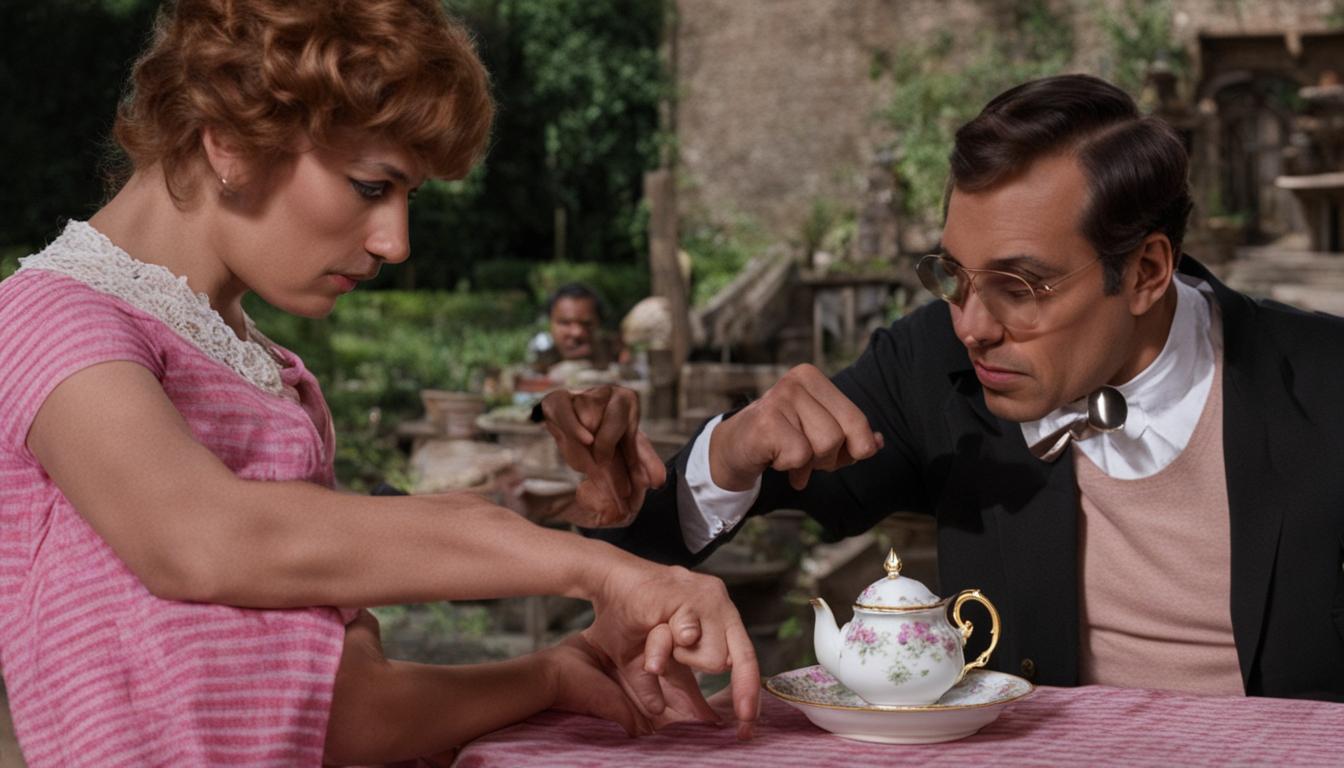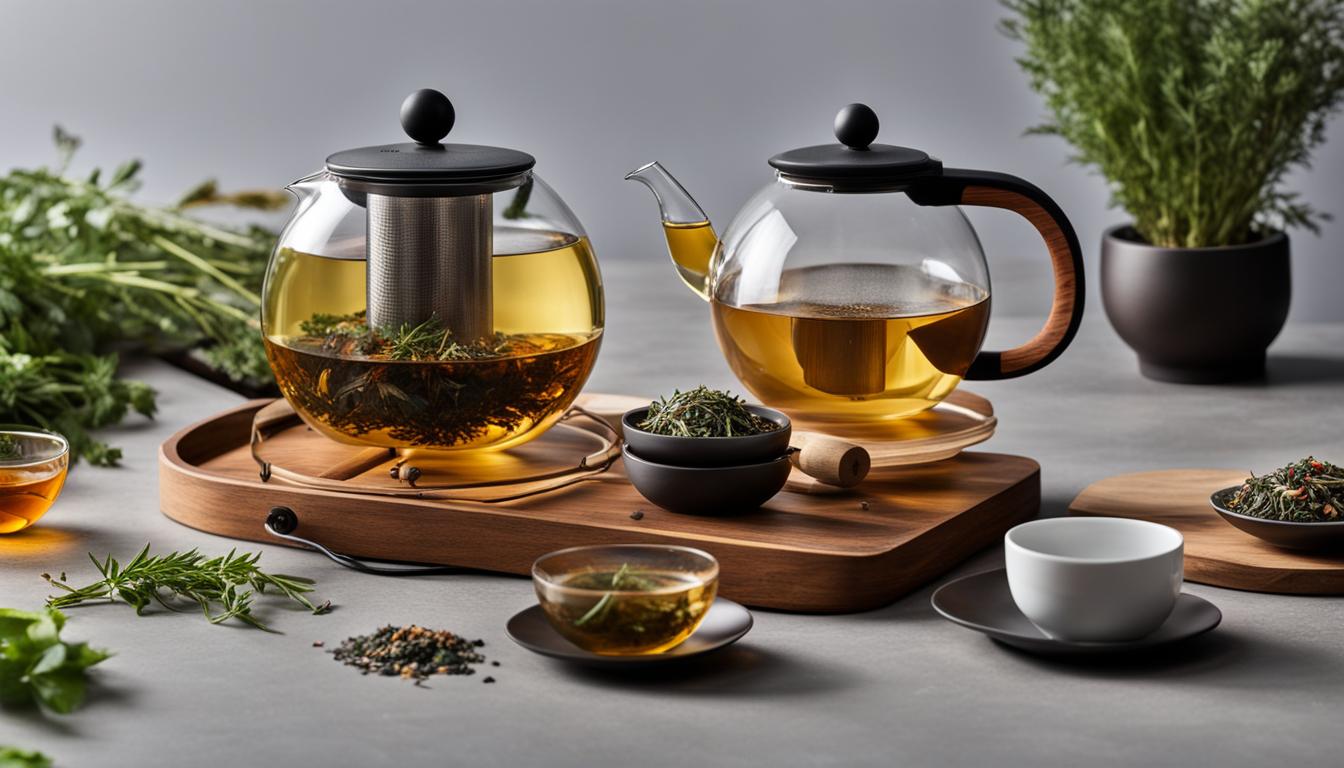Welcome to our brewing herbal tea guide. Are you ready to embark on a journey of relaxation, detoxification, and flavorful enjoyment? We’re here to equip you with the essential tools and techniques needed to brew the perfect cup of herbal tea.
First things first, let’s talk about the must-have equipment. You’ll need a trusty tea cup, a tea strainer for loose leaves, and a kettle to boil water. These items are the foundation of your tea brewing adventures.
Now comes the fun part – selecting your herbal tea. With a vast array of options available, from calming chamomile to invigorating peppermint, there’s a tea to suit every taste and purpose. Whether you’re seeking a mood boost or a relaxing experience, our brewing guide will help you find the perfect herbal tea to match your needs.
Once you have your equipment and tea of choice, it’s time to dive into the brewing techniques. We’ll teach you how to bring out the best flavors and create a soothing cup of herbal tea that will leave you feeling refreshed and rejuvenated.
Key Takeaways:
- Essential equipment for brewing herbal tea includes a tea cup, tea strainer, and kettle.
- Choose an herbal tea that aligns with your taste and purpose, ranging from uplifting to calming options.
- Master the brewing techniques to bring out the best flavors in your herbal tea.
- Enhance the flavor of your herbal tea with optional add-ins like honey, sugar, lemon, or mint.
- Cold brewing is a refreshing alternative to hot brewing, especially during hot summer months.
Choosing the Right Herbal Tea
When it comes to brewing herbal tea, selecting the right herbs is crucial for both flavor and health benefits. Different herbs offer unique flavors and therapeutic properties, so it’s essential to choose herbs that match your preferences and desired outcomes.
For those seeking an uplifting cup of tea that boosts energy, herbs like lavender, thyme, and spearmint are excellent choices. These herbs can provide a refreshing and invigorating experience to start your day or enhance focus during the afternoon slump.
If relaxation is your goal, chamomile is a popular herb known for its calming effects. Brewing a cup of chamomile tea before bedtime can help promote a restful night’s sleep and soothe stress and anxiety.
“I love brewing a cup of chamomile tea in the evening. It helps me unwind and prepares me for a peaceful sleep.” – Tea Lover
When battling a cold or congestion, specific herbs can provide relief and soothing effects. Eucalyptus, cinnamon, ginger, and licorice root are known for their therapeutic properties, helping to alleviate cold symptoms and support respiratory health.
Remember to consider your goals and preferences when choosing herbs for your tea brewing. Whether you’re seeking a boost of energy, relaxation, or relief from common ailments, the right selection of herbs can elevate your herbal tea experience.
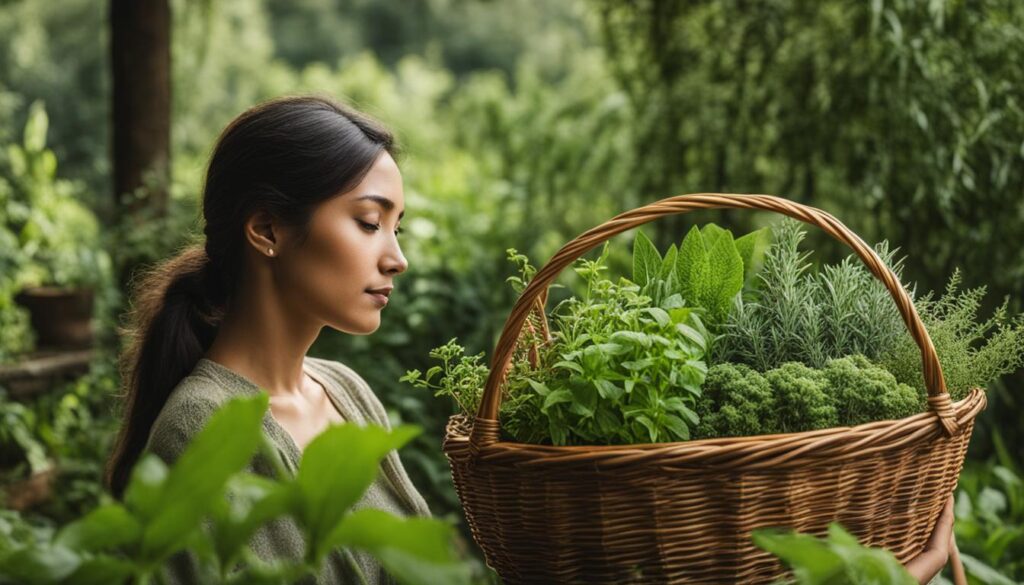
| Herb | Flavor | Health Benefits |
|---|---|---|
| Lavender | Subtle floral notes | Relaxation, improving sleep quality |
| Thyme | Earthy, savory | Boosting immune system, respiratory health |
| Spearmint | Cooling, refreshing | Improving digestion, reducing stress |
| Chamomile | Mild, apple-like | Calming, soothing, sleep aid |
| Eucalyptus | Cool, minty | Relieving congestion, respiratory health |
| Cinnamon | Warm, spicy | Antioxidant properties, warming effects |
| Ginger | Zesty, slightly spicy | Eases digestion, anti-inflammatory |
| Licorice Root | Sweet, earthy | Soothes throat, supports respiratory health |
Experience the Power of Herbal Tea
With a wide variety of herbs to choose from, brewing herbal tea offers a world of flavors and health benefits. Experiment with different combinations to create your unique blends and discover the perfect cup of tea that suits your taste and wellness goals.
“I love exploring different herb combinations for my herbal tea. It’s like creating a personalized wellness potion!” – Tea Enthusiast
Whether you’re looking to boost your energy, relax and unwind, or support your overall well-being, herbal tea can provide natural and enjoyable solutions. Stay tuned for the next section, where we’ll dive into the brewing process to bring out the best flavors in your herbal tea.
The Brewing Process
When it comes to brewing herbal tea, the process is simple and straightforward. Here’s a step-by-step guide to help you achieve a strong and flavorful brew:
Step 1: Heat the Water
Start by heating water in a kettle until it reaches a rolling boil. The water should be hot enough to extract the flavors from the herbs.
Step 2: Measure the Tea
Next, measure the appropriate amount of tea leaves or tea bags based on the recommended ratio. For loose tea leaves, use about a teaspoon per cup, with an additional teaspoon for the teapot. If using tea bags, use one bag per cup.
Step 3: Steep the Tea
Add the hot water to the teapot or cup containing the tea leaves or bags. Let the tea steep for around 5 minutes. Unlike other types of tea, herbal tea can steep for longer without becoming bitter.
Step 4: Enhance the Flavor (optional)
To enhance the flavor of your herbal tea, you can consider adding optional add-ins like honey, sugar, sliced lemon, or mint. These additions can complement the natural flavors of the herbs and make your tea even more enjoyable.
| Herbal Tea Infusion Methods | Brewing Herbal Tea for Strong Flavor |
|---|---|
| Hot Water Infusion | Steeping the tea in hot water for 5 minutes or longer to extract the maximum flavor. |
| Cold Water Infusion | Refrigerating tea leaves or bags in cold water for several hours or overnight to create a refreshing and flavorful cold herbal tea. |
| Double Infusion | Steeping the same tea leaves or bags multiple times to extract different flavors and intensities. |
| Enhanced Infusion | Adding optional ingredients like honey, sugar, lemon, or mint to intensify and customize the flavor of the herbal tea. |
“Brewing herbal tea is a delightful and customizable experience. With the right equipment, choice of herbs, and brewing techniques, you can create a variety of flavorful and healthful herbal infusions.”
Now that you have learned the brewing process, you are ready to enjoy a perfectly brewed cup of herbal tea packed with strong flavors and natural goodness.
Enhancing the Flavor
When it comes to brewing herbal tea, there are endless possibilities for enhancing its flavor. Adding optional add-ins can elevate the taste and make your tea even more enjoyable. Consider experimenting with the following flavor-enhancing ingredients:
- Honey: A natural sweetener that adds a touch of sweetness and depth to your tea.
- Sugar: If you prefer a sweeter taste, sugar can be a great addition to balance out any bitterness.
- Sliced Lemon: For a refreshing and citrusy twist, add a few slices of lemon to your cup.
- Mint: Fresh mint leaves can provide a cooling effect and a burst of freshness to your tea.
Feel free to mix and match these add-ins to create your own unique flavor combinations. For example, try adding a squeeze of lemon and a drizzle of honey to your chamomile tea for a soothing and subtly sweet experience. Remember, herbal tea is versatile, allowing you to customize it to your personal preference.
“The secret to a truly flavorful cup of herbal tea lies in the art of adding the perfect extras. From the vibrant citrusy notes of sliced lemon to the soothing sweetness of honey, the possibilities for flavor enhancement are endless. Let your taste buds guide you in creating the ultimate herbal tea experience!”
Infographic: Herbal Tea Flavor Enhancements
| Add-In | Description |
|---|---|
| Honey | A natural sweetener that adds a touch of sweetness and depth to your tea. |
| Sugar | For those with a sweeter tooth, sugar can balance out any bitterness and add extra sweetness. |
| Sliced Lemon | Refreshing and citrusy, sliced lemon brings a zesty twist to your cup of herbal tea. |
| Mint | Fresh mint leaves provide a cooling effect and a burst of freshness to your herbal tea infusion. |
Use this handy infographic as a quick reference guide for enhancing the flavor of your herbal tea. Feel free to get creative and explore other add-ins to suit your taste preferences. Remember, the goal is to create a cup of herbal tea that is uniquely yours!
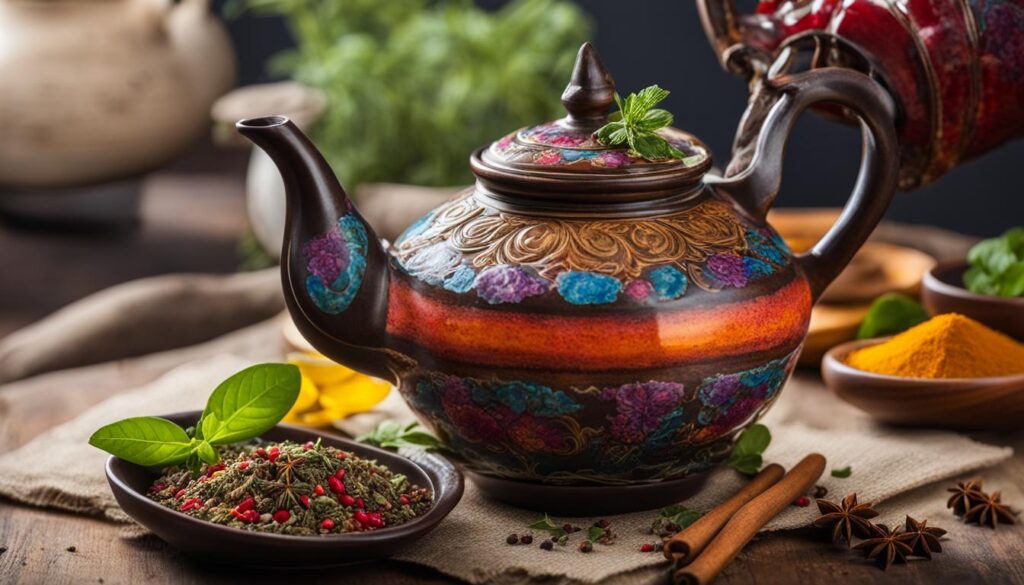
Cold Brewing Herbal Teas
When it comes to enjoying a refreshing and flavorful cup of herbal tea, you don’t always need hot water. Cold brewing is a popular method that offers a unique and delightful experience, especially during the hotter months. This technique allows the flavors of the herbs to infuse slowly, resulting in a smooth and less bitter taste. Let’s explore how to cold brew herbal teas and discover the benefits of this alternative brewing method.
To cold brew herbal tea, start by selecting your favorite herbs or tea blends. You can choose single herbs like chamomile or experiment with mixes like lavender and mint. Once you have your herbs, add them to a pitcher or jar filled with cold water. Use about one tablespoon of herbs per cup of water, but feel free to adjust it based on your taste preferences. Cover the pitcher or jar, and then place it in the refrigerator for several hours or overnight to allow the flavors to infuse.
After the cold brewing process, strain out the herbs using a fine-mesh strainer or cheesecloth. You can now enjoy your cold herbal tea as it is or add some ice cubes to make it even more refreshing. Cold brewed herbal teas are known for their smooth and mellow flavors, making them a perfect choice for those who prefer a lighter taste. Plus, cold brewing retains the natural benefits of the herbs, making it a healthy and enjoyable beverage option.
When it comes to cold brewing herbal teas, the options are endless. You can experiment with different herb combinations, such as citrusy blends with lemongrass and orange peel or soothing mixes with chamomile and lavender. Cold brewed herbal teas are versatile and can be customized based on your taste preferences or desired health benefits. So, why not try this alternative brewing technique and discover a whole new world of refreshing flavors?
| Benefits of Cold Brewing Herbal Teas | Advantages |
|---|---|
| Smooth and mellow flavors | 1. Retains natural benefits of herbs |
| Less bitterness compared to hot brewing | 2. Refreshing and hydrating |
| Lighter taste, perfect for hot days | 3. Customizable with various herb combinations |
| Convenient and easy to prepare | 4. Enjoyable as a healthy alternative to sugary beverages |
Drying Herbs for Tea Brewing
When it comes to creating your own herbal tea blends, drying herbs is a crucial step. Drying herbs allows you to preserve their flavors and aromas, ensuring you have a steady supply of ingredients for your tea brewing adventures.
To dry herbs for tea brewing, you can either harvest fresh herbs from your garden or source them from a local market. Once you have your herbs, it’s important to dry them thoroughly to prevent spoilage. One method is to hang them in a well-ventilated area, such as a warm and dry room, allowing air to circulate around the herbs. Alternatively, you can use a food dehydrator to expedite the drying process. Make sure to follow the manufacturer’s instructions for optimal drying conditions.
After the herbs have dried completely, it’s time to store them for future use. The key to maintaining the freshness of dried herbs is to store them in airtight containers. Mason jars or glass containers with tight-fitting lids work well for this purpose. Keep the containers in a cool, dark place to protect the herbs from light and heat, which can degrade their quality over time. Properly dried and stored herbs can be used for tea brewing or added to other culinary creations to infuse delightful flavors.
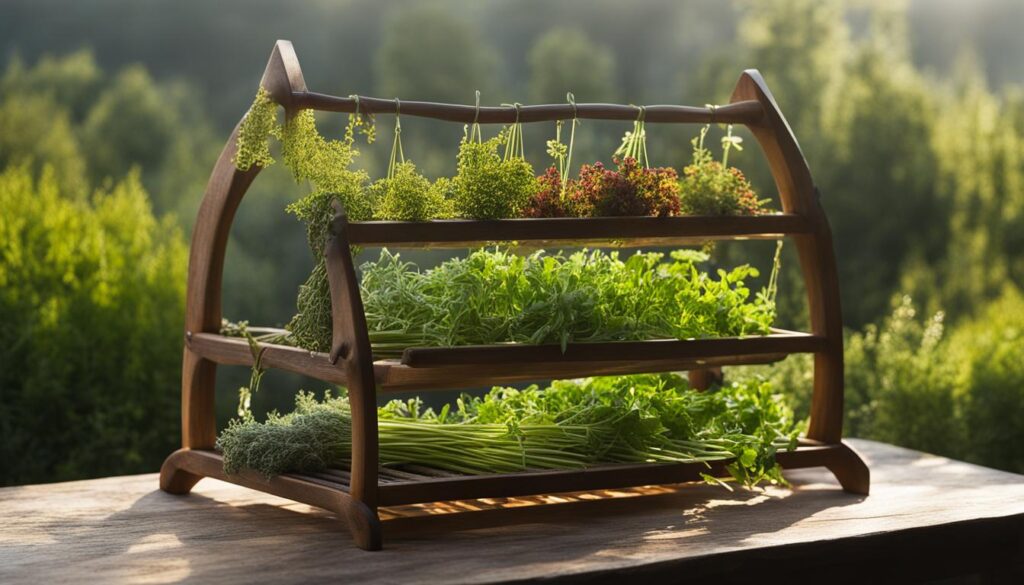
Benefits of Drying Herbs for Tea Brewing
Drying herbs for tea brewing offers several benefits. Firstly, it allows you to have a year-round supply of herbs, even when they are out of season. By drying herbs at their peak freshness, you capture their flavors and aromas, ensuring a quality brew every time. Additionally, homemade tea blends using dried herbs give you the freedom to experiment and create unique flavor combinations tailored to your taste preferences.
Recommended Herbs for Drying
| Herb | Best for |
|---|---|
| Lavender | Relaxation and stress relief |
| Peppermint | Digestive health and fresh breath |
| Chamomile | Calming and sleep aid |
| Rosemary | Mental clarity and focus |
| Nettle | Detoxification and allergy relief |
These herbs are just a few examples of the many options available for drying and tea brewing. Explore different herbs to find the flavors and benefits that resonate with you.
Herbal Tea Brewing Time Guidelines
When it comes to brewing herbal tea, understanding the optimal steeping time is essential for achieving the perfect flavor and aroma. While traditional teas like black or green tea have specific steeping times, herbal teas offer more flexibility. The recommended brewing time for herbal teas can vary depending on the type of herb used and personal preference.
Finding the Right Steeping Time
As a general guideline, most herbal teas can be steeped for around 5 minutes to bring out the best flavors. However, unlike other teas, herbal tea can steep for longer without becoming bitter. In fact, some herbal teas benefit from a longer steeping time. For example, chamomile tea tends to taste better when steeped for 10-15 minutes, allowing the flavors to fully develop. On the other hand, if you prefer a milder taste, you can steep it for a shorter duration.
Experimenting with different steeping times is the key to finding your preferred strength and taste. For stronger flavors, consider using extra tea leaves or bags instead of prolonging the steeping time. This technique helps maintain the balance of flavors without risking bitterness.
| Herbal Tea | Recommended Steeping Time |
|---|---|
| Chamomile | 10-15 minutes |
| Peppermint | 5-7 minutes |
| Hibiscus | 7-10 minutes |
| Lemon Balm | 5-7 minutes |
Remember, tea brewing is an art that allows you to personalize your experience. Don’t be afraid to experiment with different steeping times and find what works best for you. Whether you prefer a subtle infusion or a robust flavor, adjusting the steeping time can help you achieve the desired results. Sit back, relax, and savor the soothing and invigorating qualities of a well-brewed cup of herbal tea.
By following these herbal tea brewing time guidelines, you can enjoy the perfect cup of herbal tea every time. Remember to consider the specific herbs you’re using and adjust the steeping time to suit your taste preferences. Whether you’re brewing chamomile, peppermint, hibiscus, or lemon balm, experimenting with different steeping times will help you unlock the full potential of your herbal tea’s flavors and benefits.
Conclusion
We’ve reached the end of our brewing herbal tea guide, and we hope you’ve found it helpful and informative. Remember, brewing herbal tea is not only about making a delicious beverage, but also about incorporating natural wellness into your daily routine.
With the right equipment, careful selection of herbs, and proper brewing techniques, you can create a variety of flavorful and healthful herbal infusions that suit your taste and needs. Whether you’re looking for a soothing cup to unwind after a long day or an invigorating blend to boost your energy, there’s an herbal tea out there for you.
So, whether you prefer the traditional hot brewing method or the refreshing cold brewing technique, feel free to experiment with different herbs and flavor combinations. Don’t be afraid to add your personal touch by incorporating honey, lemon, or mint to enhance the taste. The possibilities are endless.
Now that you have the knowledge and tools to embark on your herbal tea brewing journey, it’s time to grab your favorite tea, get that kettle boiling or pitcher chilling, and enjoy the soothing and invigorating benefits of a perfectly brewed cup. Cheers to your continued exploration of the wonderful world of herbal tea!
FAQ
What equipment do I need for brewing herbal tea?
Essential equipment for brewing herbal tea includes a tea cup, tea strainer, and kettle.
How do I choose the right herbal tea?
The choice of herbal tea depends on your taste and purpose. Different herbs offer various flavors and health benefits, so consider your goal and preferences when selecting herbs.
What is the brewing process for herbal tea?
Start by heating water in a kettle to a rolling boil. Measure the appropriate amount of tea leaves or tea bags based on the recommended ratio. Add hot water to the teapot or cup with the tea leaves/bags and let it steep for around 5 minutes.
Can I enhance the flavor of herbal tea?
Yes, you can add optional add-ins like honey, sugar, sliced lemon, or mint to elevate the flavor of your herbal tea. Experiment with different combinations to find your favorite flavor profile.
How do I cold brew herbal tea?
To cold brew herbal tea, add tea leaves or bags to cold water in a pitcher or jar. Cover and refrigerate the mixture for several hours or overnight. Strain out the tea leaves/bags and enjoy a refreshing and flavorful cold herbal tea.
How do I dry herbs for tea brewing?
Harvest fresh herbs from your garden or purchase them from a local market. Dry the herbs thoroughly by hanging them in a well-ventilated area or using a food dehydrator. Once dried, store them in airtight containers to maintain freshness.
How long should herbal tea steep?
While steeping for around 5 minutes is a good starting point, herbal tea can be steeped longer without becoming bitter. Aim for 15 minutes to 4 hours of steeping time, depending on your preferred strength and taste.

